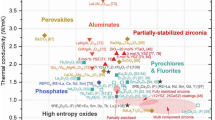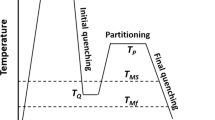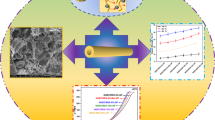Abstract
Iron–chromium–aluminium (FeCrAl) alloy compositions should be optimised to improve performance. The effects of Nb and Mo on the high-temperature steam oxidation of FeCrAl alloys were investigated at 1200 °C. The oxide film of a series of alloys with different Nb contents mainly comprised Al2O3 and the surface morphology was wrinkled. For the series alloys with different Mo contents, when Mo was greater than 2 wt.%, the oxide film component also contained MoO3, in addition to Al2O3, with the presence of micropores. The oxidation weight gain decreased with Nb, owing to a great many Laves phases, which impeded the outward diffusion of Al. The oxidation weight gain increased with Mo, and this was attributed to the volatilisation of MoO3, which promoted the diffusion of oxygen. The yield strength of FeCrAl alloys increased with increased Nb and Mo and decreased with oxidation time. Nb and Mo promoted the precipitation of the Laves phases and increased the hindrance to grain boundaries, which favoured fine grain strengthening. This was critical to obtaining FeCrAl fuel cladding alloys with great steam oxidation resistance and mechanical properties.













Similar content being viewed by others
References
P. Hofmann, Current Knowledge on Core Degradation Phenomena, A Review, J. Nucl. Mater., 1999, 270, p 194–211.
X.F. Lv, D.G. Lu, and B. Liu, Mechanism of Zirconium-Water Reaction for Pressurized Water Reactor, At. Energy Sci. Technol., 2010, 3, p 299–303.
M.N. Cinbiz, N. Brown, K.A. Terrani, R.R. Lowden, and Donald Erdman III, The Mechanical Response Evaluation of Advanced Claddings During Proposed Reactivity Initiated Accident Conditions, Energy Mater., 2017, pp. 355–365
X. Wu, T. Kozlowski, and J.D. Hales, Neutronics and Fuel Performance Evaluation of Accident Tolerant FeCrAl Cladding Under Normal Operation Conditions, Ann. Nucl. Energy., 2015, 85, p 763–775.
D.J. Park, H.G. Kim, and J.Y. Park, A Study of the Oxidation of FeCrAl Alloy in Pressurized Water and High-Temperature Steam Environment, Corros. Sci., 2015, 94, p 459–465.
J. Wang and R. Dailey, Accident Tolerant Fuels (FeCrAl Cladding & Coating) Performance Analysis in Boiling Water Reactor (BWR) by the MELCOR 186 UDGC, Nucl. Eng. Des., 2021, 371, p 110974.
Y.Y. Zhang, H.Y. Sun, and H. Wang, Effects of Cr Element on the Crystal Structure, Microstructure, and Mechanical Properties of FeCrAl Alloys, Mater. Sci. Eng. A, 2021, 826, p 142003.
R.B. Rebak, K.A. Terrani, W.P. Gassmann, and J.B. Williams, Improving Nuclear Power Plant Safety with FeCrAl Alloy Fuel Cladding, MRS Adv., 2017, 21–22, p 1217–1224.
J.K. Bunn, R.L. Fang, M.R. Albing, A. Mehta, and M.J. Kramer, A High-Throughput Investigation of Fe-Cr-Al as a Novel High-Temperature Coating for Nuclear Cladding Materials, Nanotechnol., 2015, 26, p 274003.
K.O. Gunduz and A. Visibile, The Effect of Additive Manufacturing on the Initial High Temperature Oxidation Properties of RE-Containing FeCrAl alloys, Corros. Sci., 2021, 188, p 109553.
W.J. Ding, H. Shi, and A. Jianu, Molten Chloride Salts for next Generation Concentrated Solar Power Plants: Mitigation Strategies Against Corrosion of Structural Materials, Sol. Energy Mater. Sol. Cells, 2019, 193, p 298–313.
K.G. Field, M.N. Gussev, and Y. Yamamoto, Deformation Behaviour of Laser Welds in High Temperature Oxidation Resistant Fe-Cr-Al Alloys for Fuel Cladding Applications, J. Nucl. Mater., 2014, 454, p 352–358.
G. Berthomé, E. N’Dah, Y. Wouters, and A. Galerie, Temperature Dependence of Metastable Alumina Formation During Thermal Oxidation of FeCrAl Foils, Mater. Corros., 2005, 56, p 389–392.
C. Badini and F. Laurella, Oxidation of FeCrAl Alloy: Influence of Temperature and Atmosphere on Scale Growth Rate and Mechanism, Surf. Coat. Technol., 2001, 135, p 291–298.
J. Engkvist, U. Bexell, M. Grehk, and M. Olsson, High Temperature Oxidation of FeCrAl-alloys—Influence of Al-Concentration on Oxide Layer Characteristics, Mater. Corros., 2009, 60, p 876–881.
J.G. Chęcmanowski and B. Szczygieł, Effect of a ZrO2 Coating Deposited by the Sol–Gel Method on the Resistance of FeCrAl Alloy in High-Temperature Oxidation Conditions, Mater. Chem. Phys., 2013, 139, p 944–952.
D. Pan, R.Q. Zhang, H.J. Wang, Y. Xu, and H. Wang, In Steam Short-Time Oxidation Kinetics of FeCrAl Alloys, J. Mater. Eng. Perform., 2018, 27, p 6407–6414.
D. Pan, R.Q. Zhang, H. Wang, C. Lu, and Y.M. Liu, Formation and Stability of Oxide Layer in FeCrAl Fuel Cladding Material Under High-Temperature Steam, J. Alloys Compd., 2016, 684, p 549–555.
C.S. Giggins and F.S. Pettit, Oxidation of Ni -Cr -Al Alloys Between 1000 and 1200°C, J. Electrochem. Soc., 1971, 118, p 1782–1789.
T.H. Huang, D. Naumenko, P. Song, Lu. Jiansheng, and W.J. Quadakkers, Effect of Titanium Addition on Alumina Growth Mechanism on Yttria-Containing FeCrAl-Base Alloy, Oxid. Met., 2018, 90, p 671–690.
J.P. Wilber, M.J. Bennett, and J.R. Nicholls, Life-Time Extension of Alumina Forming FeCrAl–RE Alloys: Influence of Alloy Thickness, Mater. High Temp., 2000, 17, p 125–132.
W.H. Zhang, Y. Qian, R.R. Sun, X.D. Lin, and M.Y. Yao, Oxidation Characteristics of Fe22Cr5Al3Mo-xNb Alloys in High Temperature Steam, Corros. Sci., 2021, 191, p 109722.
J. Eklund, B. Jönsson, A. Persdotter, and J. Liske, The Influence of Silicon on the Corrosion Properties of FeCrAl Model Alloys in Oxidizing Environments at 600 °C, Corros. Sci., 2018, 144, p 266–276.
R. Liu, H.L. Sun, Q.Q. Guo, M.J. Jiang, and X.S. Jiang, A Study of the Oxidation of Gd-Doped FeCrAl in 1000 °C Steam Environments, J. Mater. Eng. Perform., 2022
D. Singh, P. Sharma, and A. Parashar, Atomistic Simulations to Study Point Defect Dynamics in Bi-Crystalline Niobium, Mater. Chem. Phys., 2020, 255, p 123628.
Y. Yamamoto, B.A. Pint, and K.A. Terrani, Development and Property Evaluation of Nuclear Grade Wrought FeCrAl Fuel Cladding for Light Water Reactors, J. Nucl. Mater., 2015, 467, p 03–716.
H. Najafi, J. Rassizadehghani, and A. Halvaaee, Mechanical Properties of as Cast Microalloyed Steels Containing V, Nb and Ti, Mater. Sci. Technol., 2007, 23, p 699–705.
J. Xu, X.Q. Zhao, and S.K. Gong, Effect of Mo on the Oxidation Behaviour of NiTiAl Alloy, Mater. Sci. Forum, 2007, 62, p 1481–1484.
Y.C. Fang, Y.G. Chen, C.L. Wu, X.B. Duan, and S.R. Wang, The Effects of W or Mo on the High-Temperature Properties of Fe-21Cr Alloy Interconnects, J. Funct. Mater., 2010, 41, p 1469–1472.
J. Shu, H.Y. Bi and X. Li, The Effects of Molybdenum Addition on High Temperature Oxidation Behaviour at 1,000 °C of Type 444 Ferritic Stainless Steel, Oxid. Met., 2012, 78, p 253–267.
J. Xu, X. Zhao, and S. Gong, Effect of Nb on the High Temperature Oxidation Behaviour of TiNiAl Alloys, Acta Metall. Sin., 2006, 42, p 820–826.
X.Y. Cheng, X.J. Wan, and J.N. Shen, Effect of Nb on oxidation Behaviour of TiAl at High Temperature, J. Chin. Soc. Corros. Prot., 2002, 22, p 69–71.
F.A. Golightly, F.H. Stott, and G.C. Wood, The Influence of Yttrium Additions on the Oxide-Scale Adhesion to an Iron-Chromium-Aluminium Alloy, Oxid. Met., 1976, 10, p 163–187.
V.K. Tolpygo, The Morphology of Thermally Grown α-Al2O3 Scales on Fe-Cr-Al Alloys, Oxid. Met., 1999, 51, p 449–477.
V.K. Tolpygo and D.R. Clarke, Wrinkling of α-Alumina Films Grown by Thermal Oxidation—I. Quantitative Studies on Single Crystals of Fe–Cr–Al Alloy, Acta Mater., 1998, 46, p 5153–5166.
T.B. Zhang, H. Ding, and Z.H. Deng, Synergistic Effect of Nb and Mo on Oxidation Behaviour of TiAl Based Alloy at High Temperature, Rare Met. Mater. Eng., 2012, 41, p 33–37.
Z. Yang, J. Pan, and Z.X. Wang, New Insights into the Mechanism of Yttrium Changing High-Temperature Oxide Growth of Fe-13Cr–6Al–2Mo–0.5Nb Alloy for Fuel Cladding, Corros. Sci., 2020, 172, p 108728.
Z.Q. Sun, P.D. Edmondson, and Y. Yamamoto, Effects of Laves Phase Particles on Recovery and Recrystallization Behaviours of Nb-Containing FeCrAl Alloys, Acta Mater., 2018, 144, p 716–727.
P. Pérez, M.F. López, and J.A. Jiménez, Oxidation Behaviour of Al-Alloyed ZrSi2 at 700 °C, Intermetallics, 2000, 08, p 1393–1398.
H.S. Seo, D.W. Yun, and K.Y. Kim, Oxidation Behaviour of ferritic Stainless Steel Containing Nb, Nb–Si and Nb–Ti for SOFC Interconnect, Int. J. Hydrogen Energy, 2012, 38, p 2432–2442.
L. Shen, B.J. Wu, K. Zhao, and H.B. Peng, Reason for Negative Effect of Nb Addition on Oxidation Resistance of Alumina-Forming Austenitic Stainless Steel at 1323 K, Corros. Sci., 2021, 191, p 109754.
Y.X. Xu, J.T. Lu, X.W. Yang, J.B. Yan, and W.Y. Li, Effect and Role of Alloyed Nb on the Air Oxidation Behaviour of Ni-Cr-Fe Alloys at 1000 °C, Corros. Sci., 2017, 127, p 10–20.
Y.X. Xu, J.T. Lu, W.Y. Li, and X.W. Yang, Oxidation Behaviour of Nb-Rich Ni-Cr-Fe Alloys: Role and Effect of Carbides Precipitates, Corros. Sci., 2018, 140, p 252–259.
C.L. Wu, L.G. Ma, Y.F. Zhu, X.Q. Guo, Y.L. Wu, Z. Wu, X. Zhang, and L.H. Hou, High-Temperature Reaction Mechanism of Molybdenum Metal in Direct Coal Liquefaction Residue, Catal, 2022, 12(8), p 926–939.
S.J. Wu, J. Li, C.J. Li, Y.Y. Li, and L.Y. Xiong, Preliminary Study on the Fabrication of 14Cr-ODS FeCrAl Alloy by Powder Forging, J. Mater. Sci. Technol., 2021, 83, p 49–57.
P. Wang, Z. Gao, and D.F. Cheng, Effect of Ni–P Alloy Coating on Microstructures and Properties of Vacuum Brazed Joints of SiCp/Al Composites, Mod. Phys. Lett. B, 2017, 31, p 1750082.
O. Yuya and M.-F. Eri, High-Temperature Oxidation Behaviour and Its Oxide Layer Structure Formed on Ti-Nb Alloys, J. Jpn. Inst. Met., 2018, 82, p 232–239.
X.R. Ren, H.J. Li, and Q.G. Fu, TaB2–SiC–Si Multiphase Oxidation Protective Coating for SiC-Coated Carbon/Carbon Composites, J. Eur. Ceram. Soc., 2013, 33, p 2953–2959.
M.-F. Eri and T. Yoshinobu, Fabrication of TiO2/SiO2 Composite Coating via a High-Temperature Self-Organizing Microporous TiO2 Layer on Ti, J. Jpn. Inst. Met. Mater., 2018, 82, p 2008–2014.
K.A. Terrani, S.J. Zinkle, and L.L. Snead, Advanced Oxidation-Resistant Iron-Based Alloys for LWR Fuel Cladding, J. Nucl. Mater., 2014, 448, p 420–435.
Acknowledgments
This work was supported by The National Key Research and Development Program of China (No. 2019YFB1901000).
Author information
Authors and Affiliations
Corresponding authors
Additional information
Publisher's Note
Springer Nature remains neutral with regard to jurisdictional claims in published maps and institutional affiliations.
Supplementary Information
Below is the link to the electronic supplementary material.
Rights and permissions
Springer Nature or its licensor (e.g. a society or other partner) holds exclusive rights to this article under a publishing agreement with the author(s) or other rightsholder(s); author self-archiving of the accepted manuscript version of this article is solely governed by the terms of such publishing agreement and applicable law.
About this article
Cite this article
Wang, C., Zhang, H., Pan, J. et al. Effects of Nb and Mo on 1200 °C Steam Oxidation and Mechanical Properties of FeCrAl Alloys for Fuel Cladding Materials. J. of Materi Eng and Perform 33, 3519–3531 (2024). https://doi.org/10.1007/s11665-023-08232-6
Received:
Revised:
Accepted:
Published:
Issue Date:
DOI: https://doi.org/10.1007/s11665-023-08232-6




